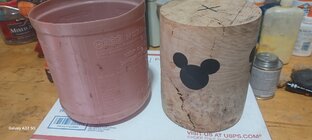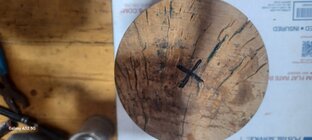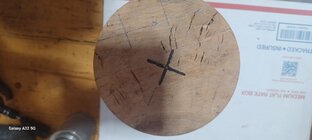Hello, all. I am new to epoxy and looking for pointers. This pencil holder project started with a 6" cube of maple(?) burl. I made 7/8" & 1-1-1/2" ebony dowels 1-1/4" long: 7/8" drilled and glued first, followed by the larger 1-1/2", before turning to the 5-1/4" cylinder in the pictures.
Now I need to decide how/when to deal with the non-structural cracks/fissures in the wood. I can blow air thru some of them, others not. The largest, on the side, is less than 1/4" wide, with most of them in the 1/16" or less range, on sides and top/bottom.
I have a pressure pot, compressor and vacuum pump, and have found a suitable 6" cylindrical mold. I think that I want to force epoxy into the voids now, before turning to final shape, but unsure whether to use vacuum or pressure?
Or, should I turn to rough shape and then "putty" some 5 minute epoxy and/or CA sawdust into whatever shows up then, and turn/sand to final?
What type of epoxy should I use? I have some table top, but don't think that's right.
How is epoxy typically finished?
Thank you!



Now I need to decide how/when to deal with the non-structural cracks/fissures in the wood. I can blow air thru some of them, others not. The largest, on the side, is less than 1/4" wide, with most of them in the 1/16" or less range, on sides and top/bottom.
I have a pressure pot, compressor and vacuum pump, and have found a suitable 6" cylindrical mold. I think that I want to force epoxy into the voids now, before turning to final shape, but unsure whether to use vacuum or pressure?
Or, should I turn to rough shape and then "putty" some 5 minute epoxy and/or CA sawdust into whatever shows up then, and turn/sand to final?
What type of epoxy should I use? I have some table top, but don't think that's right.
How is epoxy typically finished?
Thank you!



